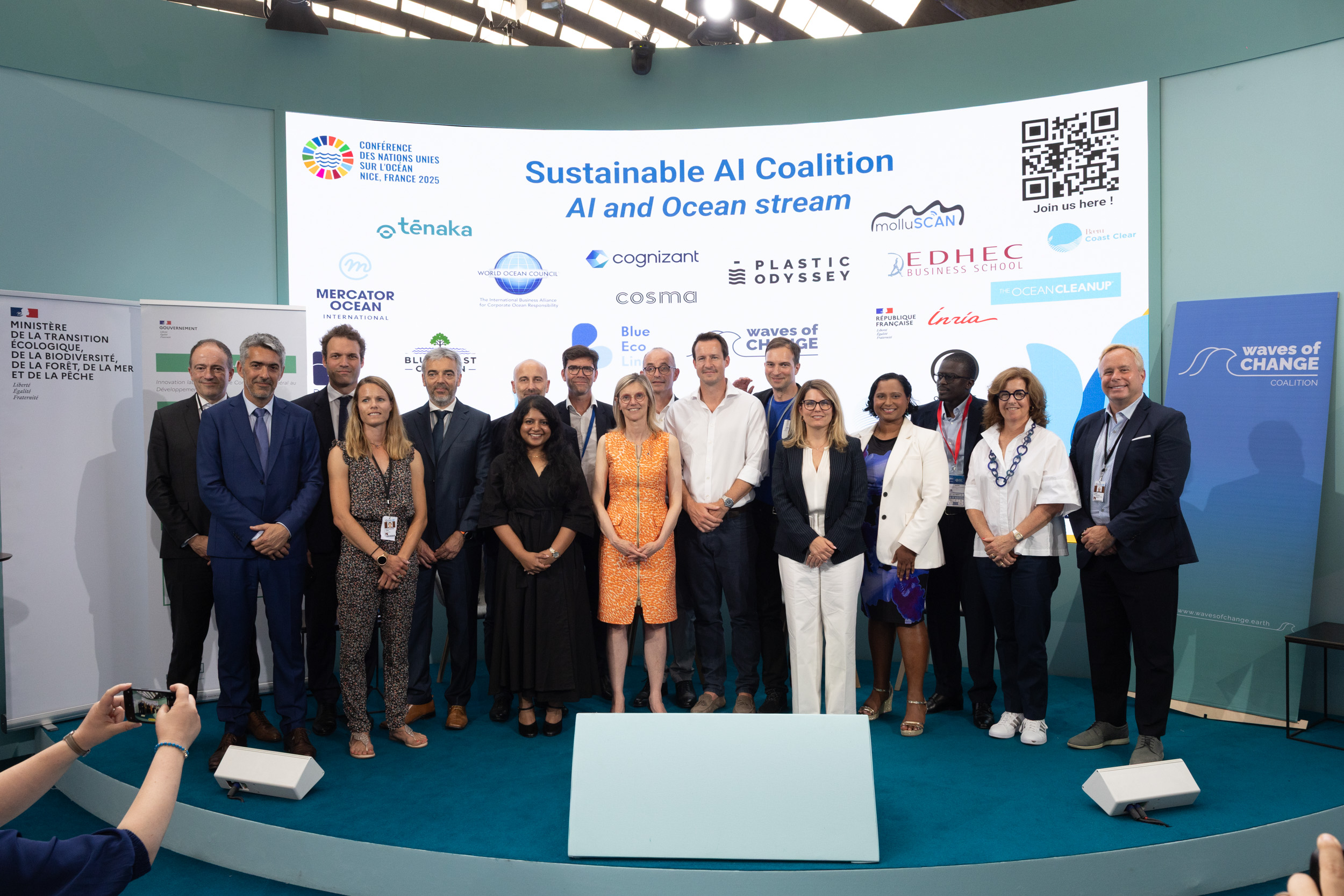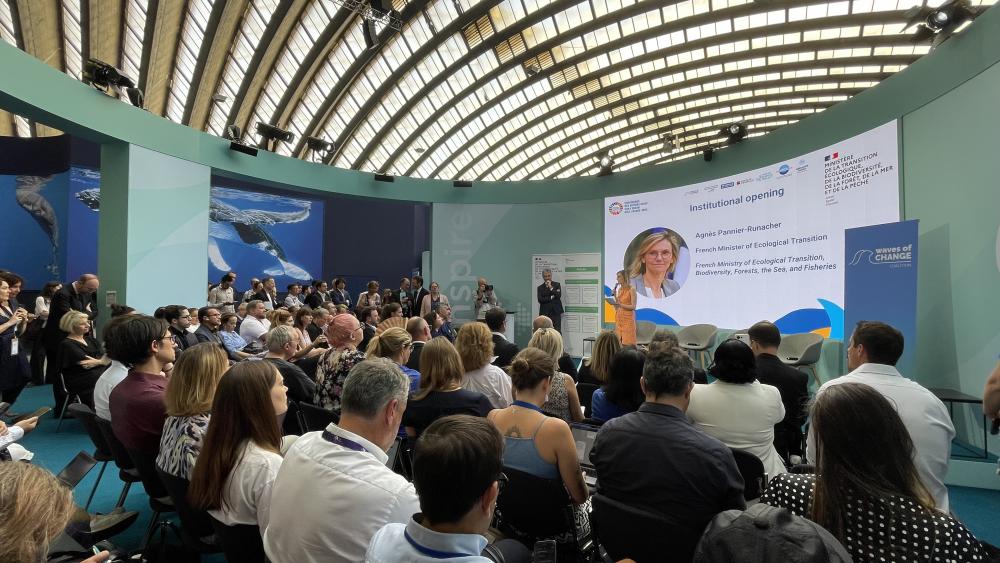
In a week marked by World Oceans Day, commemorated on June 8, the III United Nations Conference (UNOC-3) featured the participation of 70 heads of state and government, along with international agencies, local authorities, civil society (NGOs, scientists, companies), and donors, who had the opportunity to participate in various activities and forums to dialogue and address issues related to the protection and study of the ocean.
During the event, held in the city of Nice, the parallel event “AI & Bluetech: The Next Wave of Ocean Protection” took place, organized by Ecolab—the innovation laboratory of the General Commission for Sustainable Development (CGDD) and the General Directorate of Maritime Affairs, Fisheries, and Aquaculture (DGAMPA), both from the French Ministry of Ecological Transition—in association with Waves of Change, Société Générale, Ocean Purpose Project, World Ocean Council, Mercator Ocean International and the Métropole Nice Côte d’Azur.
The AI & Bluetech side event was inaugurated by the French Minister of Ecological Transition, Agnès Pannier-Runacher, and featured the participation of the Director of Inria Chile and of the Franco-Chilean Binational Center on Artificial Intelligence, Nayat Sánchez-Pi.
During the activity, the incorporation of Inria Chile and the Franco-Chilean Binational Center on Artificial Intelligence into the Coalition for Sustainable AI was officialized. Together with 22 organizations, they will form part of a new thematic axis of the Coalition, focused on AI and the Ocean.
The Coalition for Sustainable AI, of which Inria has been a part since its launch at the AI Action Summit in Paris, brings together more than 150 organizations worldwide. It is an initiative driven by France, in collaboration with the United Nations Environment Programme and the International Telecommunication Union. It aims to build a global community of stakeholders willing to contribute to initiatives to align AI development with global sustainability goals and promote responsible AI that supports environmental policies.
At the beginning of the side event, the French Minister of Ecological Transition, Agnès Pannier-Runacher, presented the new thematic focus of the coalition: Artificial Intelligence and the Ocean, which will have three main objectives:
- Promoting AI applications that really contributes to the protection of ocean and the resilience of coastal communities;
- Supporting knowledge sharing and international cooperation between blue tech companies, scientific institutions and coastal territories; and
- Encouraging responsible investment in sustainable digital solutions focused on the Ocean.
Minister Pannier-Runacher also advocated for the creation of a "triangular alliance" between science, which provides knowledge; technology, which expands tools; and public policies, which ensure alignment with the common interest.
Verbatim
I am very proud that Inria Chile and the Franco-Chilean Binational Center on Artificial Intelligence can join the Coalition for Sustainable AI. I hope we can work collectively, all together, with this community on concrete actions of sustainable AI for the protection of the Ocean and our environment.
Director of Inria Chile; Director of the Franco-Chilean Binational Center on Artificial Intelligence
Inria Chile and OcéanIA: developing artificial intelligence to understand and protect the ocean
After joining the Coalition, Inria Chile highlighted the OcéanIA project, one of its key initiatives in this field. In her keynote, Nayat Sánchez-Pi began by reviewing the approaches and studies that Inria Chile has taken regarding the convergence between artificial intelligence and the understanding of climate change, as well as ocean healing. In her analysis, she pointed out three relevant axes in this convergence:
- The application of AI to optimize processes and data to better understand the functioning of the ocean.
- Using AI to understand the complexity of climate change phenomena in the ocean.
- The growing environmental footprint of AI due to energy consumption and CO2 emissions from increasingly larger models, and promoting AI work that reduces its environmental impact.
To address those challenges, Nayat Sánchez-Pi recounted Inria Chile's efforts to contribute to these work axes. She noted that, thanks to the collaboration of various Franco-Chilean institutions, the OcéanIA project has managed to provide greater knowledge about the functioning of the ocean and, at the same time, promote the development of more efficient and low environmental impact AI models.
What is OcéanIA?
It is the most emblematic project of Inria Chile's work in this line, focusing on understanding the complexities of the global ocean symbiote. Its main objective is to develop new artificial intelligence and mathematical modeling tools to understand the structure, functioning, underlying mechanisms, and dynamics of the ocean, as well as its crucial role in the regulation and maintenance of the biosphere and the fight against climate change.
The project gathers researchers from the Inria Paris Centre, through the ANGE project-team, the Inria Centre at Université Côte d'Azur, through the GREENOWL (formerly BIOCORE) project-team, and the Inria Saclay Centre, through the TAU project-team. Other participating institutions include the Fondation Tara Océan, the GO-SEE Federation (CNRS), the Laboratoire d'Océanographie de Villefranche (CNRS-SU), and Nantes Université. In Chile, in addition to Inria Chile researchers, it brings together researchers from the Center for Mathematical Modeling (CMM) and the Pontificia Universidad Católica de Chile.
Subsequently, Sánchez-Pi addressed the main results of the OcéanIA project, grouped into four interrelated aspects:
- To understand the functions of ocean ecosystems, such as carbon capture, a form of symbolic regression was developed, an explainable machine learning tool that finds mathematical equations from data, understandable to marine biologists. This helps identify which ocean ecosystems capture more CO2 and should be protected.
- A significant effort was made in the classification of plankton images, training state-of-the-art models and developing a specialized visualization technique that allows biologists to validate the quality of the results. A novel "out-of-distribution" detection method was also created to identify unknown plankton species or unreliable predictions, streamlining the annotation process and adding certainty to the models.
- AI methods were combined with modeling tools under the physics-informed machine learning scheme, developing a new model of ocean ecosystem dynamics that simulates climate change scenarios and detects tipping points for plankton extinction. This is another tool that is available and ready to use, developed in open-source code, using an open data and open model approach.
- All datasets are available to the community, and a machine learning framework has been developed that allows researchers to use the results and tools developed within the OcéanIA framework, as well as train their own models.
Related news
- Coalition for Environmentally Sustainable Artificial Intelligence
- Position Paper: five challenges for more environmentally-friendly artificial intelligence
- AI Action Summit: the OcéanIA project is selected to be presented at the Summit in Paris
- From Valparaíso to Nice: Call for Strengthened Cooperation Between Chile and France in the Ocean Domain

